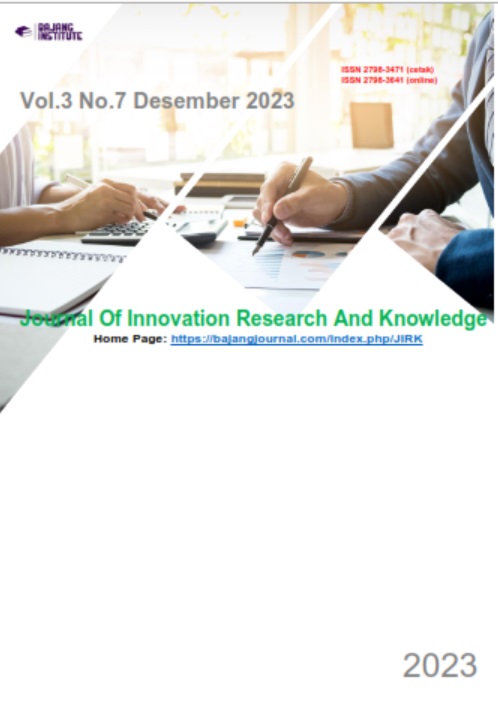TATALAKSANA EKLAMSIA PASCA SECTIO CAESARIA
DOI:
https://doi.org/10.53625/jirk.v3i7.7117Keywords:
Anesthesia, Eclampsia, Hypertension, Pregnancy, Supportive TherapyAbstract
Hypertension in pregnancy, including preeclampsia and eclampsia, is one of the complications that contribute to a significant level of morbidity and mortality. Eclampsia is a manifestation of seizures from hypertensive pregnancy, is the main cause of maternal death, and can occur before, during, or after delivery. The purpose of this case report is to describe a case of eclampsia that occurred postpartum. The patient, who was referred to Dustira Cimahi Hospital with complaints of discharge from the birth canal, was diagnosed with G1P0A0, Parturient Preterm Stage 1 Latent Phase, Gemelli, and Premature Rupture of the Membranes. The results of the examination showed hypertension and thrombocytopenia. The patient underwent a caesarian section under regional anesthesia. Both babies were born alive with normal conditions. The patient then experienced visual disturbances such as being unable to see and experiencing 3 times tonic-clonic seizures with a duration of 1 minute for each seizure. The patient was diagnosed with Post SC Eclampsia and Preeclampsia with Severe Symptoms. The patient was treated in the ICU with miloz, perdipine, ceftriaxone, mannitol, dexamethasone, citicoline, omeprazole, phenytoin, and kaltrofen. Oxygen therapy is given through noninvasive ventilation, followed by a facemask and a nasal cannula because her consciousness and breathing have improved. The key management of eclampsia is preventing maternal injury, placing the lateral decubitus position, oxygen support, monitoring vital signs, and other supportive measures.
References
Peres GM, Mariana M, Cairrão E. Pre-eclampsia and eclampsia: an update on the pharmacological treatment applied in Portugal. Journal of Cardiovascular Development and Disease. 2018;5(1): 3.
Balogun OA, Sibai BM. Counseling, management, and outcome in women with severe preeclampsia at 23 to 28 weeks’ gestation. Clinical obstetrics and gynecology. 2017;60(1): 183-9.
Pribadi A. Zero mother mortality preeclampsia program: Opportunity for a rapid acceleration in the decline of maternal mortality rate in Indonesia. International Journal of Women’s Health and Reproduction Sciences. 2021;9(3): 160-3.
Fox R, Kitt J, Leeson P, Aye CY, Lewandowski AJ. Preeclampsia: risk factors, diagnosis, management, and the cardiovascular impact on the offspring. Journal of clinical medicine. 2019;8(10): 1625.
Hauspurg A, Jeyabalan A. Postpartum Preeclampsia or Eclampsia: Defining its place and Management Among the Hypertensive Disorders of Pregnancy. American Journal of Obstetrics & Gynecology 2022: 1211-19.
Machano MM, Joho AA. Prevalence and risk factors associated with severe pre-eclampsia among postpartum women in Zanzibar: a cross-sectional study. BMC Public Health. 2020;20(1): 1-11.
Bernstein PS, Martin JN, Barton JR, Shields LE, Druzin ML, Scavone BM, et al. National Partnership for Maternal Safety. Obstetrics and Gynecology. 2017;130(2): 347–57.
Webster K, Fishburn S, Maresh M, Findlay SC, Chappell LC. Diagnosis and management of hypertension in pregnancy: summary of updated NICE guidance. BMJ. 2019; 366.
Lee LO, Bateman BT, Kheterpal S, Klumpner TT, Housey M, Aziz MF, et al. Risk of epidural hematoma after neuraxial techniques in thrombocytopenic parturients a report from the multicenter perioperative outcomes group. Anesthesiology. 2017;126(6): 1053–64.
Lapinsky SE. Management of acute respiratory failure in pregnancy. In Seminars in respiratory and critical care medicine. Thieme Medical Publishers. 2017. 38(2): 201-7.
Duley L, Meher S, Jones L. Drugs for treatment of very high blood pressure during pregnancy. 2013
Peres GM, Mariana M, Cairrão E. Pre-Eclampsia and eclampsia: an update on the pharmacological treatment applied in Portugal. J Cardiovasc Dev Dis. 2018;5(1): 3.
Chappell LC, Cluver CA, Kingdom J, Tong S. Pre-eclampsia. The Lancet. 2021;398(10297): 341-54.
Putri D, Mahendra AN, Indrayanti AW, Wirata G. Profil pemberian nifedipine kombinasi metildopa dan MgSO4 pada pasien pre-eklamsi berat di Rumah Sakit Daerah Mangusada Badung. Intisari Sains Medis. 2020;11(3): 1222-9.
Mahendra V, Clark SL, Suresh MS. Neuropathophysiology of preeclampsia and eclampsia: a review of cerebral hemodynamic principles in hypertensive disorders of pregnancy. Pregnancy Hypertension. 2021;23: 104-11.
Chrismas BG, Siti CS, Sudadi. Manajemen Anestesi untuk Seksio Sesarea pada Pasien Eklamsia dengan Perdarahan Intrakranial Jurnal Neuroanestesi Indonesia 2021;10 (2): 119–126.
Ahmed SO, Tarek EA, Waleed R. Effect of magnesium sulphate on the intracranial pressure of preeclampsia patients using ultrasound-guided optic nerve sheath diameter: A pilot study. Saudi J Anaesth 2021; 15(1): 14–18.
Ortner CM, Macias P, Neethling E, Krishnamoorthy V, Carvalho B, Swanevelder JL, Dyer RA. Ocular sonography in pre-eclampsia: a simple technique to detect raised intracranial pressure? International Journal of Obstetric Anesthesia. 2020;41: 1-6.
Changa AR, Czeisler BM, Lord AS. Management of Elevated Intracranial Pressure: a Review. Curr Neurol Neurosci Rep. 2019; 19(12): 99.
Bhatia PK, Biyani G, Mohammed S, Sethi P, Bihani P. Acute respiratory failure and mechanical ventilation in pregnant patient: A narrative review of literature. Journal of anaesthesiology, clinical pharmacology. 2016;32(4): 431.
Kurniawan A. Mechanical Ventilation Therapy on Covid-19. In 12th Annual Scientific Meeting, Medical Faculty, Universitas Jenderal Achmad Yani, International Symposium on" Emergency Preparedness and Disaster Response during COVID 19 Pandemic". Atlantis Press 2021: 108-110.













